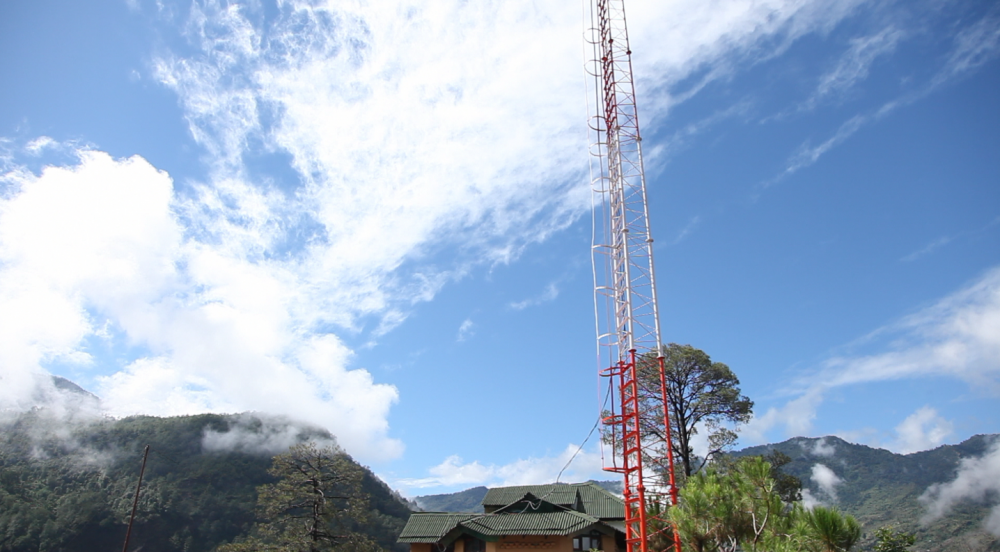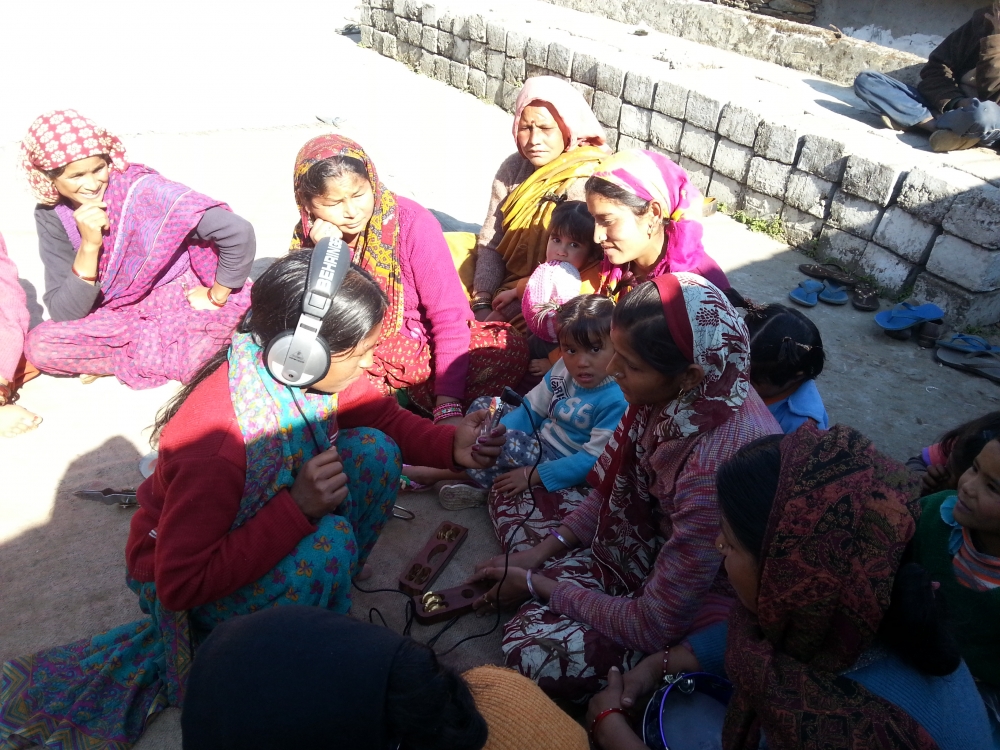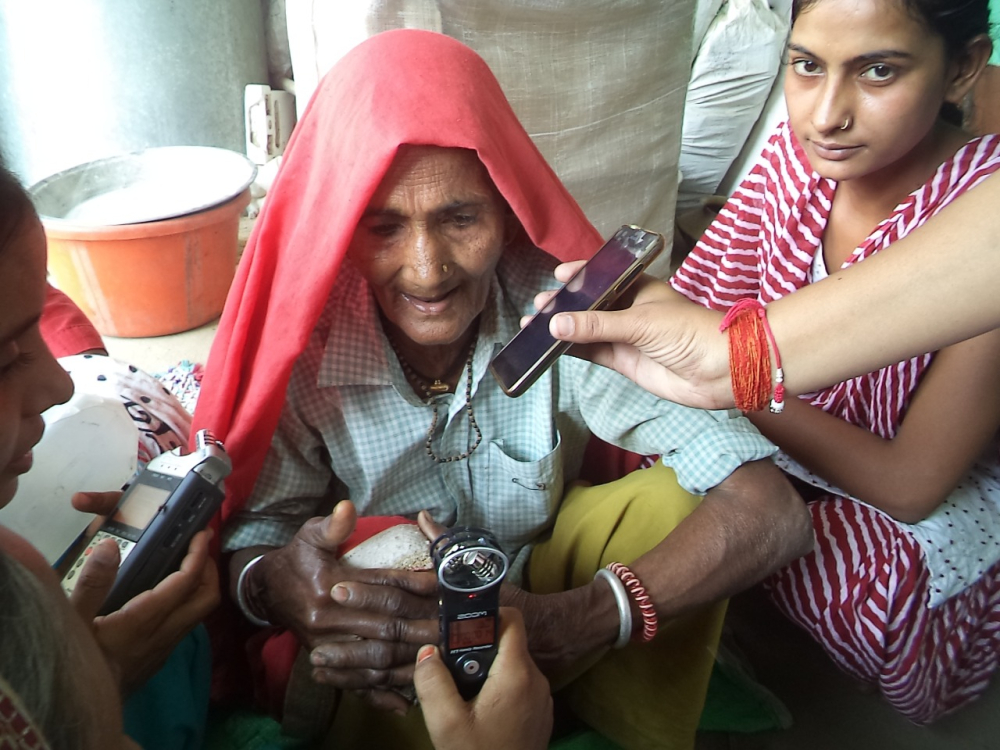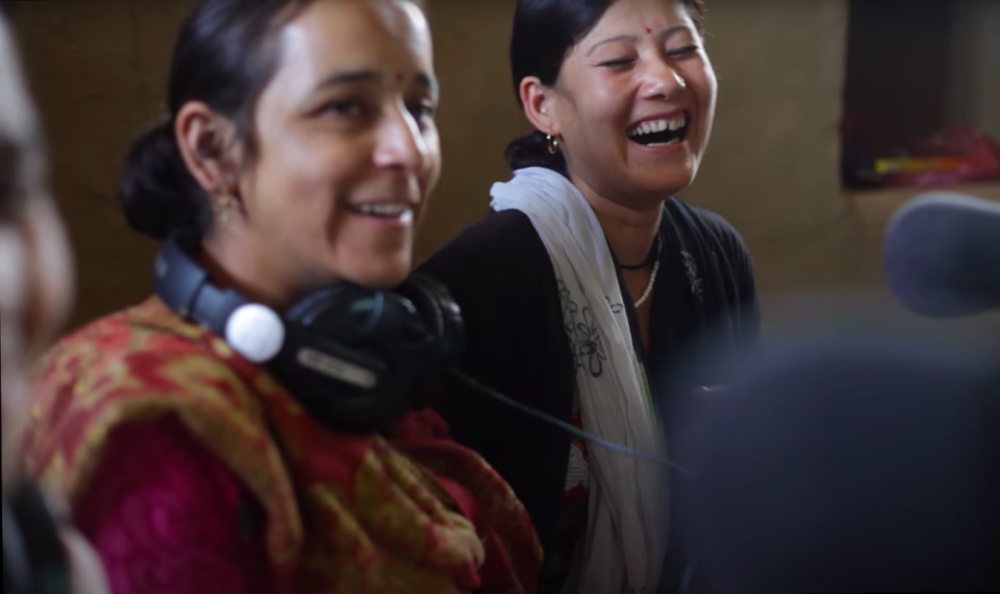‘Lyaava suna, suna meri baat, Mandakini ki awaaz, lyaava suna, suna meri baat, Mandakini ki awaaz’
(Let us listen, listen to what we have to say, the voice of the Mandakini, let us listen, listen to what we have to say, the voice of the Mandakini)
Every morning across the Mandakini river valley, chulhas (earthen stoves) of households light up as the first cups of tea get made. Women from the region head out to the forests with their baskets to gather firewood for the house and ghaas (grass) for their cattle. Cows are milked, children are readied for school, and people start heading out into the farms, offices and shops. As the Mandakini river valley stirs to life every morning, it is greeted by the familiar jingle of the local community radio station, Mandakini ki Awaaz, which begins broadcasting every morning at six and welcomes the river valley to a new day.
The words of the jingle, written by the local community radio team, reflect what lies at the heart of the community radio dream: the chance to have a platform that allows people to put forward their baat (conversations) and have it be heard. This is a dream that has resonated across diverse landscapes and communities in India.
What is Community Radio?
Community radio is essentially a community-owned and -managed radio broadcast medium. The Association Mondiale Des Radiodiffuseurs Communautaires (AMARC) defines community radio and television as ‘…private entities with public objectives. They are managed by various types of non-profit social organizations. Their fundamental characteristic is the participation of the community, in ownership as well as programming, management, operation, financing and evaluation. They are independent and non-governmental media that do not depend on or are part of political parties or private firms.’[1]
In India, community radio forms ‘a third tier of broadcasting’[2] alongside the state-owned public radio, and privately owned commercial radio. The Ministry of Information and Broadcasting of India defines community radios in India as ‘essentially low power radio stations which are meant to be set up and operated by the local community’ as a medium that allow a ‘voice to the voiceless as it provides an opportunity to the community to speak about issues concerning their lives.’[3]
The Origin of Community Radio in India
The Supreme Court judgement of 1995 that declared airwaves were public property moved India closer to the possibility of a ‘cultural broadcast mechanism that adapts perfectly to reflect the interests and needs of the community it serves and offers people of the marginalised sectors an opportunity to express themselves socially, politically and culturally.’[4] While the judgement did not immediately lead to the establishment of community radios across India, it allowed non-state actors a foot in the door by breaking the monopoly of the state over the broadcast medium. In 1999, the Indian government allowed the setting up of private commercial radio stations and later, in 2003, the mandate was broadened to allow educational institutions to broadcast from their campuses. But it was only in 2006, nearly a decade after the Supreme Court judgement, that the Government of India announced a community radio policy, finally allowing community-based organisations and non-governmental organisations to own and operate their own radio stations. The 2006 policy opened the doors of radio broadcasting to communities that previously did not have access to such forms of media production. In India, as of May 31, 2019, there are a total of 251 operational community radio stations;[5] Of these, 114 are operated by non-governmental organisations (NGOs), 122 are operated by educational institutions, and 15 are operated by agricultural universities.
The policy guidelines for setting up community radio stations in India—by educational institutions, NGOs, and community-based organisations (CBOs)—define the role that community radio stations can play in their communities. In India, community radio stations have a broadcast range of 5–10 km[6] and usually cater to communities in this defined catchment area. (Fig. 1) The guidelines mandate that the programming of community radio stations ‘reflect the special interests and needs of the local community’, that at least 50 per cent of the total content ‘be generated with the participation of the local community, for which the station has been set up’ and that programming ‘be in the local language and dialect(s)’.[7]However, these special interests and needs do not extend to news or current affairs, with the guidelines clearly stating that community radio stations ‘shall not broadcast any programmes, which relate to news and current affairs and are otherwise political in nature.’ These guidelines simultaneously promote and limit the possibilities of the medium. While the medium is defanged in one sense, its role in promoting, preserving and archiving local traditions in music, storytelling, theatre, and local knowledge systems in agriculture and farming, forestry, livelihoods, etc., is emphasised.

Cultural Significance of Community Radio in its Catchment Areas
Centering community voices
The foregrounding of people’s knowledge is the principle on which India’s first community-run radio station, Sangham Radio, was founded. The station, which began broadcasting at 90.4 Hz in 2008, is run by General Narsamma and Algole Narsamma.[8] Located in Machnoor Village in Medak District[9], Andhra Pradesh, the station, run primarily by Dalit women from the region, was set up by the Deccan Development Society (DDS). It is also the first community radio station to be run entirely by women in Asia.[10] Sangham Radio draws its name from the sanghams (groups) organised by DDS, which are collectives of women from the region. The sanghams emphasised and worked towards autonomy in several areas such as food production, agriculture, seeds, natural resources management, market, health and media.[11] In 1996, at a consultation with the Regional Communication Adviser from UNESCO, the women from the sanghams expressed their interest in running a radio station in order to articulate ‘locally relevant issues, in their own language, and in their own time.’[12]
Across the country, other community radio initiatives were launched to fulfil the need to centre minor voices and facilitate the promotion and preservation of local art forms and knowledge. (Fig. 2) In 1999, the Kutch Mahila Vikas Sangathan (KMVS) produced a weekly serial titled Kunjal Paanje Kutch Ji (The Saras Crane of Our Kutch) for the local All India Radio (AIR) Bhuj station. As artist and documentary filmmaker, Shabnam Virmani notes in the article ‘Flying with the Crane’, the show was ‘consciously planned as a vehicle for the public articulation and expression of Kutchi identity’.[13] Kutchi was decided as the language in which the show would be produced after an extensive survey conducted in the community indicated a growing demand for radio programming in the local language. As part of the Drishti Media Collective team that collaborated with KMVS in developing Kunjal Paanje Kutch Ji, Virmani shares that listeners sent in over 1,100 postcards, with one listener stating that listening to Kutchi on the radio ‘brought tears of joy to their eyes’.[14] Kunjal Paanje Kutch Ji comprised sections that featured drama, song, and local news reportage, alongside a documentary module and was anchored by the character of a kunjal (saras crane, a popular figure in Kutch folklore); the show aired for 53 episodes and won the 2000 Chameli Devi Jain award for Women in Journalism.
‘One of the mandates of community radio stations is to encourage, promote and invest in local talent. In fact, folk music, theatre (radio drama) and day-to-day narratives are the mainstay of a community radio that seeks to give a voice to the marginalised within the community and expression to the creative talent,’ observes Kanchan Malik, professor at the Department of Communication, University of Hyderabad, and faculty fellow with the UNESCO Chair on Community Media. (Fig. 3) For community radio stations like Sangham Radio and KMVS, local language and cultural traditions are inextricably linked to the idea of selfhood, and their work on local cultural practices is located in the desire to provide a platform for the ways in which people from the community see and experience the world. Local cultural traditions are not featured superficially or as an afterthought, but in deeply embedded ways that offer insights into the ways in which communities interpret their worlds. An emphasis on local cultural traditions is part of their focus on the knowledge systems of community members. The language in which community radios broadcast and the idioms and tropes employed in the programmes are an integral part of the cultural fabric of the community and are meaningful platforms of self-expression by communities. The intersection of technology with existing traditions across communities allows for new forms and methods of articulation and helps in providing a platform to cultural forms and traditions that are not featured on other existing media platforms.

In preserving and promoting local language and cultural traditions
In India, this facilitation of self-expression through technology has contributed to the promotion and preservation of local languages and cultural traditions. (Fig. 4) In areas where spoken languages are largely passed down orally and do not have a written script, the community radio functions as a dynamic archive that sustains the language by simultaneously recording and documenting the ways in which the language is used on a regular and ongoing basis and by generating interest in and engagement with the language within the community. For instance, the use of Garhwali, listed as a ‘vulnerable’ language in UNESCO’s Atlas of the World’s Languages in Danger, is promoted through the Mandakini ki Awaaz radio station in Rudraprayag District in Uttarakhand. Saritha Thomas, managing trustee and founder of People’s Power Collective, observes that after Mandakini ki Awaaz began broadcasting in the region, younger members of the community seem to have a renewed sense of pride speaking in Garhwali. Manvendra Singh Negi, one of the founding members of Mandakini ki Awaaz, shares that as part of regular programming, the station quizzes its listeners about Garhwali idioms and phrases. He notes that younger listeners are often not familiar with these idioms and phrases; however, in order to participate in the programme, they make the effort to enquire and understand the meaning and usage of the phrases, usually by asking older members of the community. This has facilitated a vibrant engagement with elements of Garhwali language that were not part of daily communication and revived use of the language patterns that may have fallen into disuse in the region.

In Mananthavady, Wayanad, Radio Mattoli broadcasts to communities who speak several diverse languages, in their catchment area. As Fr Bijo Thomas Karukappally, station manager of Radio Mattoli shares, roughly 19 per cent of adivasi communities in Kerala live in Wayanad, and apart from Malayalam, communities in Wayanad speak several other languages. Adivasi communities such as the Paniya, Kurichi, and Kattunaikan communities speak their own language; many of these languages, like Garhwali, do not have a written script and are to a large extent preserved orally. Radio Mattoli broadcasts shows in multiple local languages spoken by the communities in the catchment area; these shows produced and anchored by community members from the adivasi communities in the region, facilitate the creation of a constantly evolving, oral repository of the communities’ languages. (Fig. 5) In Orrcha, Madhya Pradesh, Radio Bundelkhand has built a significant archive of Bundeli songs through a programme called Bundeli Idol. The programme encouraged people to record a Bundeli song and send it to the radio station; these songs were then played on air, and listeners were asked to vote for their favourite song/artiste and one with the maximum number of votes was declared Bundeli Idol.[15] Through this programme, Radio Bundelkhand was able to build a repository of over 950 folk songs and promote over 150 local folk singers.[16] Community radios nurture the development of cultural traditions and facilitate a resurgence of pride in local traditions in the face of globalised knowledge systems, helping communities reclaim their cultural identities. In doing so, ‘for cultures dominated by orality’[17] it has helped ‘enhance cultural identity and community pride.’[18]
Alfaz-e-Mewat, a community radio station based in Mewat, Haryana, broadcasts to about 225 villages in its catchment community. (Fig. 6) In the Mewat region, traditional folk singers known as the merasis narrate the history and folklore of the region through their songs. Pooja Murada, founder of Alfaz-e-Mewat, shares that with traditional merasi artists dwindling in number in the region, this musical tradition is slowly disappearing in their catchment area. In a bid to preserve it, Alfaz-e-Mewat has archived several kisse (stories in a musical format) with local artistes and has also been encouraging new artistes to come to the station and record songs from merasi tradition. These are then played in a dedicated show called Kisse Kahani (Stories and Songs) which is broadcast daily in the evening. Fakat Hussain, senior reporter with Alfaz-e-Mewat, also shares that the station plays songs from the catchment area such as the songs associated with the seasons of the year known as mausam ke geet (songs of the season) and sawan ke geet (songs of the monsoon). These songs are showcased in the show, Mausiki Mewat (Folk Songs of Mewat) which attempts to showcase older traditions of music in the region which are fast losing out to newer traditions influenced by mainstream Hindi music.

Along with archiving traditions, community radio stations also preserve the voices and memories of local and regional performers. Saritha Thomas shares the story of Shankar Singh Rana, a popular musician and singer in the Mandakini Valley, who recorded one of the first songs about the community radio station and who passed away recently. Listeners often call Mandakini ki Awaaz and request songs sung by Shankar Singh Rana, nostalgic for his music and drawing comfort from his sound being preserved and kept alive through the radio station.
In Haryana, Gurgaon ki Awaaz has built a large archive of local folk songs from Haryana called raginis. Gurgaon ki Awaaz also caters to migrant communities in their catchment community. Sharmila Sharma, station manager of Gurgaon ki Awaaz, shares that their catchment community includes large migrant communities from Bihar and Garhwal who come to Gurgaon in search of better opportunities. The station caters to these communities by playing Bhojpuri and Garhwali folk songs as well as Bagheli folk songs and folk songs from Kanpur. Listeners are free to call and request songs from any of their collections in their show Apni Pasand, where the song is played along with the name of the person who requested it and the details of their native village. These measures, Sharmila feels, helps people build a relationship with the city. As community radio stations work towards recognising and addressing this diversity in their programming, a key aspect of understanding and speaking to this difference is the inclusion of varied and diverse forms of music and entertainment on the platform. This inclusion allows for the possibility of creation and nurturing of cultural communities virtually, even when they are displaced spatially.
In addressing crises in catchment communities
Disasters, natural and man-made, often disrupt the regular flow of information available to communities. Newspapers can become difficult to deliver, power blackouts can limit access to information available through television and internet, and it can often become impossible to even relay information physically between villages and communities. In such times, radio can be an efficient and effective medium to share crucial information that can be easily accessed on mobile phones and even on inexpensive and accessible radio receiver sets that do not rely on electricity. Community radios, especially, are important platforms to relay information specific to communities in their catchment areas and address localised concerns in regional languages and dialects. (Figs 7, 8 and 9)

As localised systems of communication, deeply embedded in the fabric of the communities in their catchment areas, community radios are important media platforms during various crises. Community radio stations like Mandakini ki Awaaz and Kalanjiam Samuga Vanoli[19] work in tandem with national and state disaster management agencies and the communities they are catering to in order to build disaster preparedness. Community radio stations, reaching out to communities in a 5–10 km radius, are often better informed and aware of the immediate concerns of their communities and can produce programmes tailored to the needs and requirements of their listeners. Additionally, these radio stations are often able to share this information in formats that are more easily accessible and understood by their audience.
In 2020, as India grappled with the spread of COVID-19 in the country, ensuring continuous access to timely and verified information was vital. Misinformation compounded with lack of access to official safety guidelines and verified information, exacerbated both the medical and the humanitarian crises that have unfolded in the face of COVID-19. In these times, community radio stations across India worked to ensure that verified information reaches their communities in accessible formats and languages. In Wayanad, Radio Mattoli ensured that timely, verified information was accessible to communities in their catchment areas by sharing official medical information issued by the state government. Saritha Chandra, a broadcaster with Radio Mattoli, along with other team members at the radio station compiled information shared by the government; this material was then translated from Malayalam into the local languages and shared through a variety of formats ranging from public service announcements to jingles that employed local musical traditions. Other radio stations like Alfaz-e-Mewat ran programmes through successive phases of the lockdown to address a wide range of concerns faced by their communities during the COVID crisis. Their show, 21 Din, 21 Baatein (21 Days, 21 Points) has shared important information about safety and prevention measures during the COVID pandemic, and also discussed the psychological impact of the crisis on community members.[20]
In 2007, the Ministry of Information and Broadcasting in India announced that the government intended to facilitate the setting up of 4,000 community radio stations in the country[21] over the next few years. In 2020, with less than 300 operational stations in India, this dream is far from being realised. Apart from a long bureaucratic license process, as Vinod Pavarala, senior professor at the Department of Communication at the University of Hyderabad and UNESCO Chair on Community Media, points out, the spectre of security concerns has deprived communities in certain regions of the opportunity to run their own community radio stations[22]. Further, the NGO-isation of community radio, a process marked by depoliticisation[23], and a shift from movement building to ‘professionalized but decentralized small scale organizations’’[24], can also lead to what Pavarala calls ‘a stultifying adoption of standardised genres and formats.’[25] Additionally, as Anushi Agrawal from Maraa shares, funding is often linked to content, which means that community radio stations sometimes have to run similar content across stations and communities; this takes away from the uniqueness of each station. The prohibition on broadcasting news and current affairs limits the kind of information community radios are able to relay to their communities. However, despite its challenges, as a medium that promotes localised regional forms and traditions of music and storytelling and gives local artistes and performers an accessible platform to share their work and showcase their talent, community radio is a valuable and important addition to the Indian media landscape.
As an oral medium, community radio is well suited to address the needs of several communities in India where traditions are often passed down orally and are documented and preserved in memory and performance. In a globalised media landscape, where large cultural industries shape and mould public imagination and conversation—privileging and validating certain systems of knowledge over others—it is important to build and nurture more local, community owned and sustained media platforms that draw from people’s histories and traditions and speak to the diversity within communities. Community radio is one such platform and its significance lies in being a medium where content creation is a collective process and community members are producers, performers and listeners; it is, as they say in Garhwali, ‘Apnu ku, Apnu te, apnu ki bhagidari bithin, chalan walu radio, samudayik radio ch’ (Community radio is a radio run by our own, for our own and through our participation).
Notes
[1] UNESCO, ‘Defining Community Broadcasting.’
[2] Pavarala and Malik, Other Voices, 11.
[3] Ministry of Information and Broadcasting. Outcome Budget 2013–2014, 31.
[4] Pavarala and Malik, Other Voices, 18.
[5] Ministry of Information and Broadcasting, ‘List of Operational Community Radio Stations in India as on 31-05-2019.’
[6] Ministry of Information and Broadcasting, ‘Policy Guidelines for setting up Community Radio Stations in India.’
[7] Ibid.
[8] Avadhani, ‘Sangam Radio completes seven years today.’
[9] Deccan Development Society, ‘Sangham Radio Inaugurated.’
[10] The Hindu, ‘Voices from the margins.’
[11] Pavarala and Malik, Other Voices,138.
[12] Ibid., 141
[13] Virmani, ‘Flying with the Crane.’
[14] Ibid.
[15] Townsend, ‘Just for GRINS: An Interview with Gram Vaani’s Zahir Koradia.’
[16] Development Alternatives, Radio Bundelkhand Apna Radio Apni Baatein.
[17] Pavarala and Malik, Other Voices, 17.
[18] Ibid.
[19] Chandramouli, ‘A community radio station in rural Tamil Nadu is giving a voice to those affected by climate change.’
[20] Sharma, ‘How community radios are helping fight Covid-19.’
[21] UNESCO, ‘India to establish 4000 community radio stations under new community radio policy.’
[22] Pavarala, ‘Ten Years of Community Radio in India: Towards New Solidarities,’ 2–4.
[23] Roy, ‘The NGO-ization of resistance.’
[24] Sabing, ‘The NGOization of Feminism,’ 102.
[25] Pavarala, ‘Ten Years of Community Radio in India: Towards New Solidarities,’ 2–4.
Bibliography
Avadhani, R. ‘Sangam Radio completes seven years today.’ The Hindu, Telengana, October 15, 2015. Accessed May 25, 2020. https://www.thehindu.com/news/national/telangana/sangam-radio-completes-seven-years-today/article7764216.ece.
Chandramouli, Kartik. ‘A community radio station in rural Tamil Nadu is giving a voice to those affected by climate change.’ Scroll.in. October 5, 2019. Accessed May 17, 2020. https://scroll.in/article/938383/a-community-radio-station-in-rural-tamil-nadu-is-giving-voice-to-those-affected-by-climate-change.
Converse Townsend, John. ‘Just for GRINS: An Interview with Gram Vaani’s Zahir Koradia.’ Changemakers. 2011. Accessed March 15, 2020. https://www.changemakers.com/blog/just-grins-interview-gram-vaani%E2%80%99s-zahir-koradia.
Deccan Development Society. ‘Sangham Radio Inaugurated.’ DDS India. 2008. Accessed March 10, 2020.http://www.ddsindia.com/www/sangham_radio_inaugurated.html
Development Alternatives. Radio Bundelkhand Apna radio Apni baatein. New Delhi: Development Alternatives. Accessed on Feb 20, 2020. https://www.devalt.org/images/L2_ProjectPdfs/Radio_Bundelkhand_Brochure_English.pdf?Oid=206.
Pavarala, Vinod, and Kanchan K. Malik. Other Voices: The Struggle for Community Radio in India. New Delhi: Sage, 2007.
Pavarala, Vinod. ‘Ten Years of Community Radio in India: Towards New Solidarities.’ EduComm Asia, 17 (2013): 2–4.
Ministry of Information and Broadcasting. ‘List of Operational Community Radio Stations in India as on 31-05-2019.’ Ministry of Information and Broadcasting, 2019. Accessed Feb 10, 2020, https://mib.gov.in/sites/default/files/List%20of%20251%20Operational%20CRS%20in%20India%20as%20on%2031-05-2019%28new%29.pdf.
———. Outcome Budget 2013-2014. New Delhi: Government of India. Accessed March 20, 2020. https://mib.gov.in/sites/default/files/outcomeE2013-14.pdf.
———. ‘Policy Guidelines for setting up Community Radio Stations in India’, Ministry of Information and Broadcasting. 2019. Accessed April 3, 2020. https://mib.gov.in/sites/default/files/c1_0.pdf.
Mtimde, Lumko et al. What is Community Radio? A Resource Guide. Edited by Marie-Hélène Bonin and Aida Opoku-Mensah. Africa; Southern Africa: AMARC Africa and Panos Southern Africa. Accessed on March 28, 2020. https://web.archive.org/web/20160304023107/www.amarc.org/documents/manuals/What_is_CR_english.pdf.
Roy, Arundhati. ‘The NGO-ization of Resistance.’ Massalijn. 2014. Accessed September 3, 2020. http://massalijn.nl/new/the-ngo-ization-of-resistance/.
Sharma, Manoj. ‘How community radios are helping fight Covid-19.’ Hindustan Times. New Delhi, May 29, 2020. Accessed May 29, 2020. https://www.hindustantimes.com/delhi-news/how-community-radios-are-helping-fight-covid-19/story-ayZfnpitU3OMoG8FYoRVoM.html.
Sabing, Louie. ‘The NGOisation of Feminism.’ In Transitions Environments Translations: Feminisms in International Politics, edited by Cora Kaplan, Debra Keates, and Joan W Scott, 101–120. New York: Routledge, 1997.
The Hindu. ‘Voices from the margins.’ The Hindu, June 30, 2017. Accessed March 27, 2020. https://www.thehindu.com/todays-paper/tp-miscellaneous/tp-others/voices-from-the-margins/article19183693.ece.
UNESCO. ’Defining Community Broadcasting.’ UNESCO. Accessed May 29, 2020. https://en.unesco.org/sites/default/files/unesco_cmedia_sustainability_policy_1_defining.pdf.
———. 'India to establish 4000 community radio stations under new community radio policy.’ UNESCO. 2007. Accessed May 29, 2020. http://www.unesco.org/new/en/communication-and-information/resources/news-and-in-focus-articles/all-news/news/india_to_establish_4000_community_radio_stations_under_new_c/.
Virmani, Shabnam. ‘Flying with the Crane.’ IndiaTogether. 2000.Accessed March 28, 2020. http://www.indiatogether.org/stories/radiokutch.htm.

